Wireless Charging | Voler Systems
Leave your cables at home Wireless charging eliminates the cable typically required to...
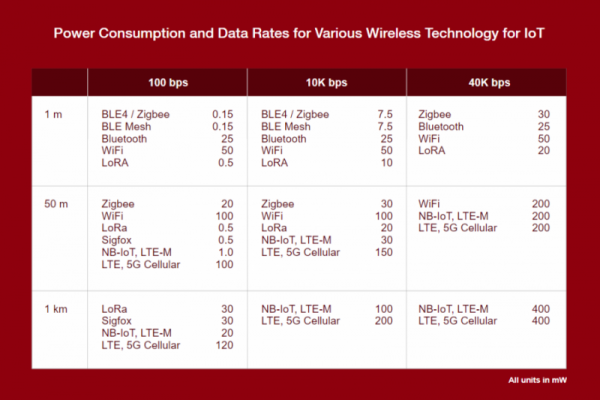
Small, thin, and lightweight are the main qualities of wearable devices and also the reason why battery life is an ongoing issue with wearable technology. Developing wearables with batteries that last requires the expertise of engineers with years of hands-on experience. Some of the techniques that call for an expert team include automated low-power mode switching, energy harvesting, and selecting the right wireless technology.
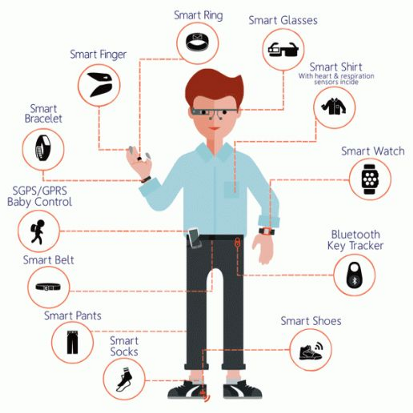
Source:
Internet of Things (loT) and wearables define today’s standard for low-power design, which requires a combination of system design, circuit design, and software to achieve an ultra-low-power solution. In this article, we will discuss the key power-saving techniques utilized by Voler for the following:
There are now many competing standards, each with its advantages and disadvantages in battery power consumption, transmission distance, and applicability to different uses. Picking the right technology has a significant impact on power consumption.
In wireless transmission, three things must be managed: (1) the power required to transmit, (2) data rate, and (3) transmission distance.
The table below shows the approximate power of different wireless technologies for different data rates and distances. This is not the only criteria for the wireless technology choice but provides a useful guideline for assessing battery requirements.
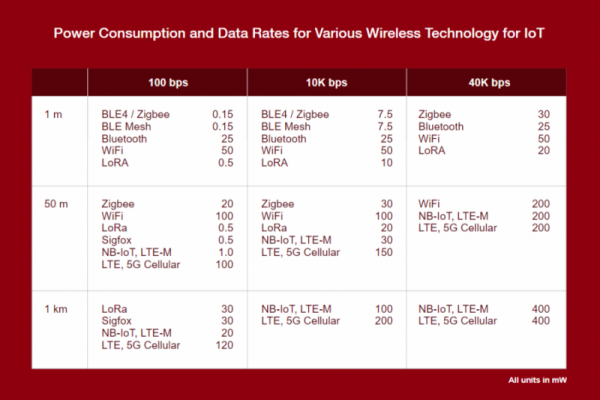
Wireless Transmission Checklist
Learn more by checking our guide to wireless technology standards.
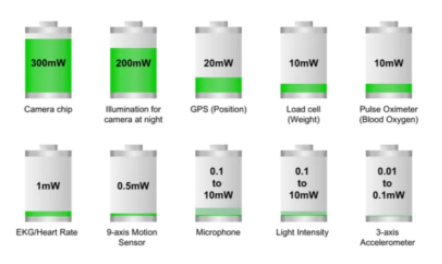
You can see that cameras and their illumination are very power-hungry. They are not very suitable for ultra-low-power devices. They are ubiquitous in cell phones, but if used continuously, even the large cell phone battery will not last a full 8 hours.
GPS is moderately power-hungry. A common way to save power is to use a motion chip for short-term position calculations. These chips are very low power, but they drift over time, and after a few minutes, their location is inaccurate. GPS can be used every few minutes to correct the motion chip errors, keeping the GPS off most of the time. However, if GPS is off too long, it takes extra time (and power) to get a position reading. For example, this happens when new satellites come into view and others go out of view.
A 3-axis accelerometer is such low power that it is often left on continuously and used to wake up the system when detecting motion above a pre-set threshold. The 3-axis accelerometer can run for months or years on a coin cell. It can trigger a microprocessor to wake up. The microprocessor can analyze the situation from multiple sensors and decide if something needs to be done. If not, it can go back to sleep to continue saving power.
People often choose sample rates to sample more rapidly than necessary. Sampling slower saves power in the sensor, saves power in the processor, and also saves on the power needed to transmit data. Carefully select the sampling rate to the minimum possible, as it can dramatically impact power.
Sensor Checklist
There is a wide range of power consumption in different microprocessors depending upon their capability. Some are down in the microwatts, and some consume many Watts. The very low-power processors are not suited to processing video, encrypting large amounts of data, or compressing large amounts of data.
Turning off the processor or putting it to sleep dramatically reduces the power. Interrupts can allow a processor to go into a deep sleep and be woken up by an external event. The interrupt requires an event such as a trigger from a 3-axis accelerometer to activate the interrupt. Sleeping adds delay (latency), which needs to be factored into the user experience.
Some things, like GPS, don’t generate interrupts. A GPS module gives you coordinates, and the processor has to go out and poll it for the data. A GPS module uses too much power to be left on continuously in most cases anyway.
Some typical processing operations:
Sensor Checklist
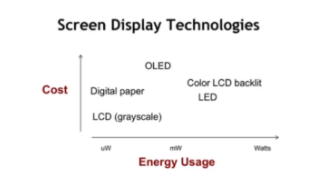
The bottom line is that color is power-hungry and will require a large battery and frequent recharging. The exception is Digital paper, which is getting better color capability every year. Grayscale LCDs, with no backlight, require very low power. OLEDs are in between but are slightly more expensive and, therefore, not as popular. Digital paper is new, but the cost is dropping.
Most watches use grayscale LCDs, and the backlight is turned on only when needed. They run on a coin cell for more than a year. Smart-watches with color LCDs can’t operate without a backlight and therefore require more power; as much as color LED displays. A motion detector can signal a device to turn on when it moves, so power is not used when it is not needed. This is not the best solution for all cases, however. It is necessary to carefully consider the user’s needs and present and future requirements when designing the device and figuring out its power consumption.
An emerging technology used in some E-readers is a digital paper called “E-ink,” which is useful because it only consumes power when you change the image. It does not support video because of its slow refresh speed, so it has not found much traction outside of E-readers and other static displays.
Individual LED lights (not displays), which are low power, are very common and are a good way to send a signal to a user. While they are low-power, they are not ultra-low-power, but there are some ways to reduce the power consumption:
Display Checklist
The software has a huge impact on power. There are many trade-offs to be made in implementing it. These trade-offs may include implementing a feature in hardware vs. software, transmitting data in bursts vs. real-time data, and sleeping vs. instant availability. You should balance cost, performance, power, and schedule to develop an optimum implementation. The user experience is a major factor in making software design decisions.
One example of a trade-off is how to implement positional information. GPS is not a low-power device. A creative way to reduce power consumption is to eliminate the need by leveraging a cell phone’s GPS instead or using an ultra-low-power motion sensor.
Although sending data in bursts saves power, sending it too infrequently may not work for the user. Power is consumed just by turning on and establishing communication. Reducing the number of times data is sent reduces this extra power. Besides, very small data packets are inefficient since the heading information that accompanies the data may be larger than the data packet.
Common causes of inefficient power consumption are:
Software Checklist
An expert electronic design team will be able to decide the most appropriate power conservation strategy. Voler’s team are wearable design experts who have developed numerous successful wearable technology products and medical devices by managing the design trade-offs between size, power, and cost. We select the best wireless standard for your application based on your project’s unique requirements and goals.
You can download our white paper on ultra-low power design checklist on extending battery life here.
Located in Silicon Valley and with more than 40 years of electronic design experience, Voler Systems continues to be a leading custom product design consulting company providing high-quality electrical engineering and firmware development. Voler Systems ensures delivery of quality products, on time, on budget with low risk. All projects are undertaken with good specifications, the right people, quality design, constant communication, and a smooth transfer to manufacturing.
